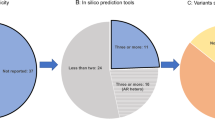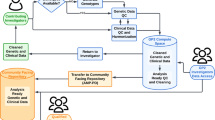Abstract
Parkinson's disease (PD) is a common degenerative neurologic disorder, which is pathologically characterized by a selective degeneration of dopaminergic neurons of the substantia nigra pars compacta, and the presence of characteristic eosinophilic inclusions, known as Lewy-bodies in affected brain areas1. The cause of PD is unknown but, in recent years, genetic factors have been implicated in the aetiology of the disease2. Firstly, clinico-genetic, epidemiologic and twin studies revealed inheritable effects3 and questioned earlier studies which had denied such influences4. Secondly, several family studies suggested autosomal-dominant inheritance of syndromes which, to variable degrees, resembled sporadic PD clinically5 and in some cases also neuropathologically6,7. Recently, a disease locus has been mapped to chromosome 4q21–22 in a large Mediterranean pedigree8, in which disease expression is clinically and pathologically within the spectrum of sporadic PD; being atypical only for a relatively young mean age at onset of 46 years and rapid course of 10 years from onset to death9. In affected individuals of this family and of three unrelated Greek kindreds, a putative disease-causing mutation has been identified in the gene encoding α-synuclein10. With the first variant being defined, genetic heterogeneity has become apparent, as in other families parkin-sonism was not linked to the 4q-locus11 and was not associated with the α-synuclein mutation (unpublished data). We describe a different genetic locus that appears to be involved in the development of parkinsonism closely resembling sporadic PD including a similar mean age of onset (59 years in the families, 59.7 years in sporadic PD; ref. 12). This locus was detected in a group of families of European origin. In two of these families, there is genetic evidence for a common founder. The penetrance of the mutation appears to be low, most likely below 40%. This is compatible with a possible role of this locus not only in familial, but also in typical (sporadic) PD.
This is a preview of subscription content, access via your institution
Access options
Subscribe to this journal
Receive 12 print issues and online access
$209.00 per year
only $17.42 per issue
Buy this article
- Purchase on Springer Link
- Instant access to full article PDF
Prices may be subject to local taxes which are calculated during checkout
Similar content being viewed by others
References
Jellinger, K. New developments in the pathology of Parkinson's disease. Adv. Neurol. 53, 1–16 (1990).
Vieregge, P. Genetic factors in the etiology of idiopathic Parkinson's disease. J. Neural Transm. Park. Dis. Dement. Sect. 8, 1–37 (1994).
Wood, N. Genes and parkinsonism. J. Neurol. Neurosurg. Psychiatry 62, 305–309 (1997).
Duvoisin, R., Gearing, F., Schweitzer, M. & Yahr, M.D. in Progress in Neurogenetics (eds Barbeau, A. & Brunette, J.R.) 492–496 (Excerpta Medica, Amsterdam, 1969).
Wszolek, Z.K. et al. Hereditary Parkinson disease: report of 3 families with dominant autosomal inheritance. Nervenarzt. 64, 331–335 (1993).
Golbe, L.I. Di lorio, G., Bonavita, V., Miller, D.C. & Duvoisin, R.C. A large kindred with autosomal dominant Parkinson's disease. Ann. Neurol. 27, 276–282 (1990).
Wszolek, Z.K. et al. Western Nebraska family (family D) with autosomal dominant parkinsonism. Neurology 45, 502–505 (1995).
Polymeropoulos, M.H. et al. Mapping of a gene for Parkinson's disease to chromosome 4q21-q23. Science 274, 1197–1199 (1996).
Golbe, L.I. et al. Clinical genetic analysis of Parkinson's disease in the Contursi kindred. Ann. Neurol. 40, 767–775 (1996).
Polymeropoulos, M.H. et al. Mutation in the α-synuclein gene identified in families with Parkinson's disease. Science 276, 2045–2047 (1997).
Gasser, T. et al. Genetic complexity and Parkinson's disease. Science 277, 388–389 (1997).
Di Rocco, A., Molinari, S.P., Kollmeier, B. & Yahr, M.D. Parkinson's disease: progression and mortality in the L-DOPA era. Adv. Neurol. 69, 3–11 (1996).
Denson, M.A. & Wszolek, Z.K. Familial parkinsonism: our experience and a review of the literature Parkinsonism Related Disord. 1, 1–8 (1995).
Ward, C.D. & Gibb, W.R. Research diagnostic criteria for Parkinson's disease. Adv. Neurol. 53, 245–249 (1990).
Wszolek, Z. et al. German-Canadian family (family A) with parkinsonism, amyotrophy, and dementia—longitudinal observations. Parkinsonism Related Disord. 3, 125–139 (1997).
Denson, M.A. et al. Familial parkinsonism, dementia, and Lewy body disease: study of family G. Ann. Neurol. 42, 638–643 (1997).
Dib, C. et al. A comprehensive genetic map of the human genome based on 5,264 microsatellites. Nature 380, 152–154 (1996).
Gibb, W.R. & Lees, A.J. The relevance of the Lewy body to the pathogenesis of idiopathic Parkinson's disease. J. Neurol. Neurosurg. Psychiatry 51, 745–752 (1988).
Mark, M.H., Dickson, D.W., Sage, J.I. & Duvoisin, R.C. The clinicopathologic spectrum of Lewy body disease. Adv. Neurol. 69, 315–318 (1996).
Hofmann, K., Duker, M., Fink, T., Lichter, P. & Stoffel, W. Human neutral amino acid transporter ASCT1: structure of the gene (SLC1A4) and localization to chromosome 2p13-p15. Genomics 24, 20–26 (1994).
Alexi, T. & Hefti, F. Trophic actions of transforming growth factor alpha on mesencephalic dopaminergic neurons developing in culture. Neuroscience 55, 903–918 (1993).
Lander, E.S. & Schork, N.J. Genetic dissection of complex traits. Science 265, 2037–2048 (1994).
Gasser, T. et al. Genetic linkage studies in autosomal dominant parkinsonism: evaluation of seven candidate genes. Ann. Neurol. 36, 387–396 (1994).
Dubovsky, J., Sheffield, V.C., Duyk, G.M. & Weber, J.L. Sets of short tandem repeat polymorphisms for efficient linkage screening of the human genome. Hum. Mol. Genet. 4, 449–452 (1995).
Cottingham, R.W., Jr., Idury, R.M. & Schaffer, A.A. Faster sequential genetic linkage computations. Am. J. Hum. Genet. 53, 252–263 (1993).
Schaffer, A.A., Gupta, S.K., Shriram, K. & Cottingham, R.W., Jr. Avoiding recomputation in linkage analysis. Hum. Hered. 44, 225–237 (1994).
O'Connell, J.R. & Weeks, D.E. The VITESSE algorithm for rapid exact multilocus linkage analysis via genotype set-recoding and fuzzy inheritance. Nature Genet. 11, 402–408 (1995).
Kruglyak, L., Daly, M.J., Reeve Daly, M.P. & Lander, E.S. Parametric and nonparametric linkage analysis: a unified multipoint approach. Am. J. Hum. Genet. 58, 1347–1363 (1996).
Ott, J. Linkage probability and its approximate confidence interval under possible heterogeneity. Genet. Epidemiol. Suppl. 1, 251–257 (1986).
Author information
Authors and Affiliations
Corresponding author
Rights and permissions
About this article
Cite this article
Gasser, T., Müller-Myhsok, B., Wszolek, Z. et al. A susceptibility locus for Parkinson's disease maps to chromosome 2p13. Nat Genet 18, 262–265 (1998). https://doi.org/10.1038/ng0398-262
Received:
Accepted:
Issue Date:
DOI: https://doi.org/10.1038/ng0398-262



